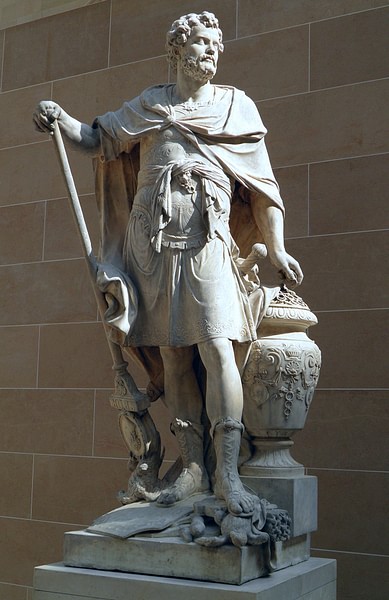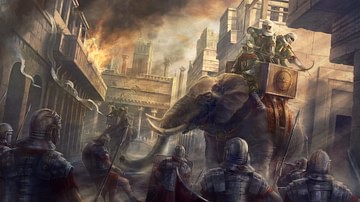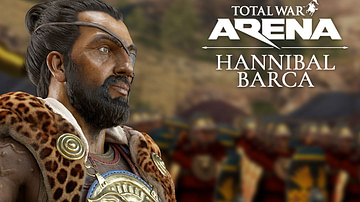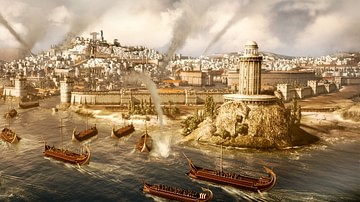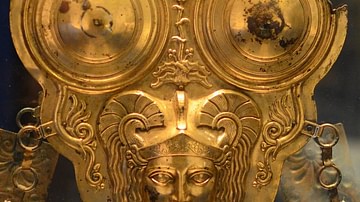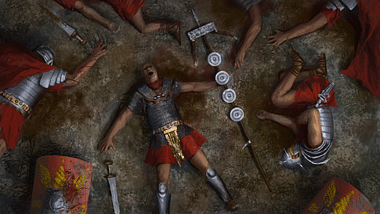
The Battle of Cannae (2 August 216 BCE) was the decisive victory of the Carthaginian army over Roman forces at Cannae, southeast Italy, during the Second Punic War (218-202 BCE). The Carthaginian general Hannibal Barca (l. 247-183 BCE), who was already known for his unorthodox tactics against Rome, counted on the Romans relying on the traditional tactics and formations which had worked so well for them in the past and used their very strengths to defeat them.
In 216 BCE, Roman military tactics were still in their infancy. Although Rome had won many impressive victories during the First Punic War (264-241 BCE) they continued to rely on their old tactic of placing a numerically superior force in the field to overwhelm the enemy. The typical Roman formation was to position light infantry toward the front masking the heavy infantry and then coordinating light and heavy cavalry on the back wings.
This formation had worked well for Rome's earlier adversary, the Greek King Pyrrhus I (r. 297-272 BCE) who, although victorious at the Battle of Asculum in 279 BCE, lost so many men that his army could not continue on to take the city (giving rise to the phrase 'Pyrrhic victory'). Pyrrhus' basic strategy was effective, however, and was adopted in Roman warfare: he would place a large force in the field, in tight formation, and rely on the superior numbers and the charge to break the opposing ranks. This tactic had worked for the Romans during the First Punic War but, at the Battle of Cannae, the Romans would learn an important lesson in military strategy from a general who fought like no other had before him and would leave a lasting legacy for Rome and the wider world.
Background of the First Punic War
The city of Carthage in North Africa was the superpower of the Mediterranean, and Rome a small, European trade city on the River Tiber, when the two came into conflict over Sicily, parts of which were controlled by both, in 264 BCE. The resulting First Punic War toppled Carthage and elevated Rome as the new power in the region. Carthage was burdened with a heavy war indemnity and their general Hamilcar Barca (l. 275-228 BCE), who had led the army against Rome, went to Spain in order to raise funds from the Carthaginian-controlled silver mines there to help pay this debt.
Hamilcar's actual intentions, however, were to regroup, reequip, and resume the war with Rome and he brought his son Hannibal (and later his younger son Hasdrubal Barca, l. c. 244-207 BCE) with him to help subdue the Iberian tribes and control the silver mines. When Hamilcar was killed in battle in 228 BCE, command of the Carthaginian forces went to his son-in-law Hasdrubal the Fair (l. c. 270-221 BCE) who chose diplomacy over military action in dealing with the Romans. In 226 BCE, the Ebro Treaty was signed between Carthage and Rome agreeing on the boundaries in Spain between Carthaginian and Roman territories. Both nations agreed they would remain in their own regions and leave the other in peace. Hasdrubal the Fair was assassinated in 221 BCE, however, and command passed to Hannibal who had sworn to his father never to make peace with Rome.
Hannibal's Aggression & Rome's Response
Hannibal started the Second Punic War when he attacked the city of Saguntum, a Roman ally, in southern Spain in 218 BCE, placing it under siege and taking it for Carthage. The Romans, citing the Ebro Treaty, demanded Hannibal be arrested and turned over to them, and when Carthage refused, war was declared.
Instead of waiting for the Romans to send forces to Spain, Hannibal decided to take the battle to them on their own ground and marched his army over the Alps into Italy, leaving Hasdrubal in command of the forces in Spain. Once descended onto the Italian plains, he began advancing through Roman territory taking small cities and villages and defeating Roman forces twice; at Trebia at the Ticino River (218 BCE) and again at Lake Trasimene (217 BCE). By 217 BCE, Hannibal held all of northern Italy and the Roman senate feared he would march upon Rome.
The Romans began to panic, fearing too little was being done by the consul, Quintus Fabius Maximus (l. c. 280-203 BCE), who had been made dictator in this time of crisis. Fabius decided on a policy of harassing Hannibal and trying to thwart his plans through strategic movements and brief skirmishes rather than full engagement, earning him the nickname cunctator (“delayer”). The Romans wanted direct action and discernible results but Fabius understood he was dealing with a clever opponent who could be expected to challenge any tacticians' expectations. He chose to try to save Roman lives by penning Hannibal up while scorching the earth to deprive the Carthaginians of supplies and so win a war of attrition.
The Roman Senate was not interested in this approach, however, and, in 216 BCE, the younger consul Minucius Rufus (dates unknown) was elected to command with Fabius. Minucius called for direct confrontation with the invading Carthaginian army and Fabius gave him command of half the Roman forces and told him to do his best. Minucius was swiftly defeated by Hannibal, who used tactics that the Roman command could not understand until it was too late, surprising him in an ambush near the town of Gerione. Minucius' forces were scattered and he had to be rescued by Fabius. According to the historian Will Durant:
The Romans could not readily forgive him [Hannibal] for winning battles with his brains rather than with the lives of his men. The tricks he played upon them, the skill of his espionage, the subtlety of his strategy, the surprises of his tactics were beyond their appreciation. (48)
After the defeat of Minucius, Fabius resigned as dictator and Rome scrambled to mobilize another force to take the field.
New Command & Prelude to Battle
The two consuls Lucius Aemilius Paulus (d. 216 BCE) and Caius Terentius Varro (served c. 218-200 BCE) who replaced Fabius both favored abandoning his delaying tactics and meeting Hannibal head-on in battle. Varro, especially, called for immediate engagement in spite of Fabius' warnings that Rome could not defeat Hannibal in open combat. Paulus, who seems to have had doubts about Varro's proposal, feared that he would be ridiculed by the people as Fabius had been and so reluctantly agreed with the strategy of direct confrontation. Scholar Ernle Bradford comments:
The senate were determined that year on battle. They had the support not only of the people but also of the equites, the aristocratic knightly caste. All sections of the population, although there was great division among them – division that had been fostered by men like Varro – were determined to avenge the defeats that Rome had suffered in the campaigns of the previous two years, and to expunge the slight that had been cast upon the Roman name by the presence of the Carthaginian general and his makeshift army in the land of Italy. Not only their honor and their traditions called them out to offer their services; it also seems that plebeians and aristocrats alike realized that Rome, not just the city but the whole concept of Roma Eterna, had reached a crisis point. (108-109)
While the Romans were arguing strategy and forming plans, Hannibal was on the move and took the significant supply depot of Cannae at some point in early 216 BCE. With Cannae under his control, he then expanded his reach to the surrounding regions. The Romans, in a panic, demanded an immediate response and, in July of 216 BCE, Paulus and Varro led a force of over 80,000 against Hannibal's less than 50,000 at Cannae.
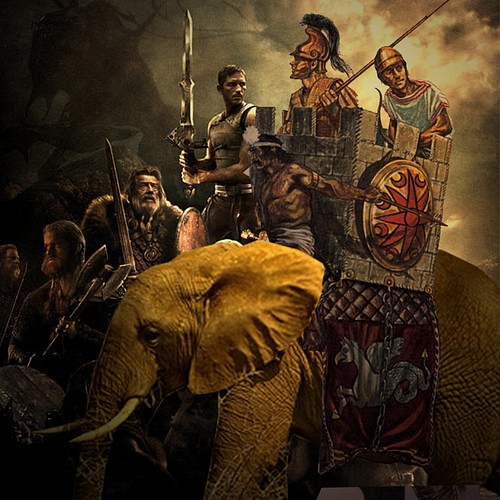
Varro commanded one half of the force and Paulus the other. As they marched, Hannibal ambushed Varro's command but was beaten back. Varro claimed this skirmish as a great victory, which improved the morale of his troops, but Paulus was beginning to have greater doubts as to the wisdom of the coming engagement. Even so, according to historians like Livy and Appian, he recognized it was too late now to withdraw and so encamped his troops approximately one mile (2 km) away from Hannibal's army.
The Battle of Cannae
The opposing forces faced each other for two days, during which time Hannibal sent small raiding parties to harass the Romans. On the day of battle, Hannibal disguised his intentions by placing his light infantry of Gauls at the front to mask his heavier infantry whom he positioned in a crescent formation behind them. At a given signal just before battle, the light infantry fell back to form two wings of reserves. Hannibal's light and heavy cavalry were positioned at the extreme wings of the position. Hannibal had spent the past two days observing the Roman legions and positioned his forces to exploit all potential weaknesses in his adversaries.
The Romans, following their usual understanding of battle in which superior forces would overwhelm by sheer strength, arrayed their forces in traditional formation with light infantry masking the heavier and the cavalry also to the wings. Because Hannibal had been in position first, his location dictated the Roman deployment and field of battle. The Roman army, therefore, was curtailed on their right flank by the Aufidus River, with a hill to their rear, leaving the area to their left flank as the only avenue of retreat should the battle go against them. Varro was confident of victory, however, and formed his lines so it appeared his forces only matched, or were even less than, Hannibal's while massing his infantry in the center behind the front line.
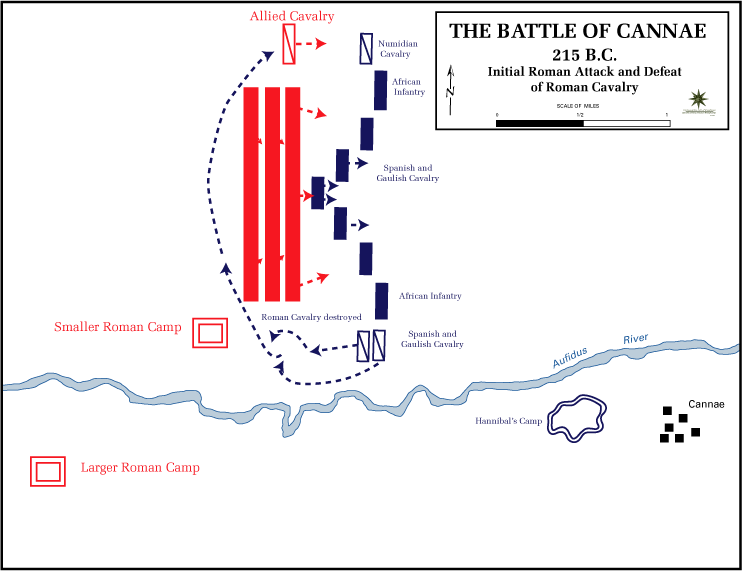
When the Roman legions began their march toward the Carthaginian lines, the Carthaginian infantry fell back before them. The Romans took this as a positive sign that they were winning and pressed on. The Carthaginian light infantry, who had earlier fallen back, now took up position on either end of the crescent formed by their heavy infantry. At this same time, the Carthaginian cavalry charged the Roman cavalry and engaged them.
The Roman infantry continued their charge into the enemy's ranks but, precisely because of their traditional formation, could make no use of their superior numbers. Those soldiers massed behind the front line, and further toward the back of the ranks, merely served to push those before them onward. This would normally have served to break the enemy's lines at the center, but Hannibal carefully withdrew that center toward the wings as the Romans continued advancing. At the same time, the Carthaginian heavy cavalry drove back the Roman cavalry, opening a breach in the lines to the rear of the infantry.
As the cavalry forces engaged, and as the Roman infantry continued its advance, Hannibal signaled for the trap to close. The light infantry which formed the ends of the crescent of the Carthaginian line now moved up to form an alley in which the Roman forces found themselves trapped. The Carthaginian cavalry fell upon the Roman infantry from behind, the light infantry attacked from the flanks, and the heavy infantry engaged from the front.
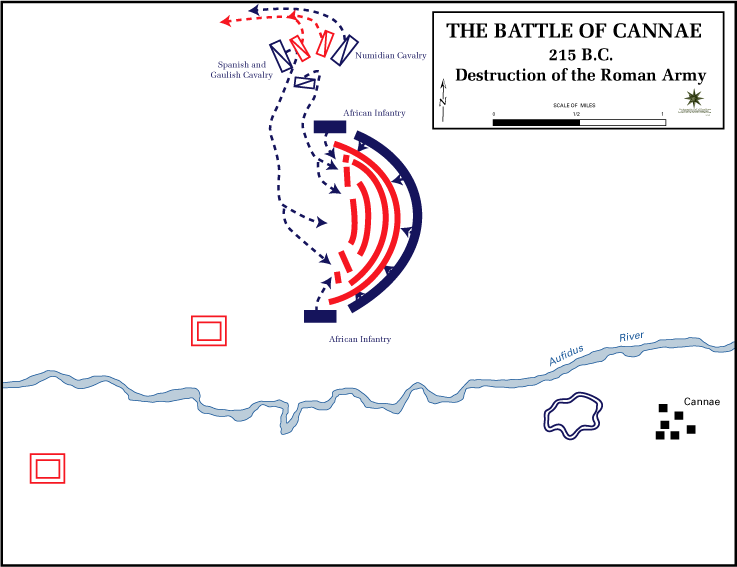
The Romans were surrounded and were almost completely annihilated. Out of the over 50,000 who took the field, 44,000 were killed and those who survived, by fleeing through the area of their left flank, managed to escape to Canusium. Hannibal lost 6,000 men, mostly the Gauls, who had made up the front lines. According to Durant:
It was a supreme example of generalship, never bettered in history. It ended the days of Roman reliance upon infantry and set the lines of military tactics for two thousand years. (51)
Just as the Romans had earlier learned from their adversary Pyrrhus, so they would now learn from Hannibal but, before the lesson could be internalized, they would have to deal with their almost overwhelming grief.
Conclusion
Hannibal's victory at Cannae completely demoralized Rome and threw the city into a full-blown panic. So many men had been killed that there was no family which had not lost one of their own or a close friend. Mourning rites continued throughout the days while the Romans tried to understand what had caused the defeat and finally resorted to human sacrifice in an effort to appease their gods.
Fabius, who had formerly been the object of ridicule for his tactics, was now hailed as a hero while Varro was villainized as a fool whose rash behavior and overconfidence had cost Rome its bravest soldiers and citizens. Fabius' efforts at this time went far in restoring some semblance of order. He decreed that mourning rites should be conducted within the home, thus bringing order to public life, and should be concluded within a month's time. Afterwards, a public ceremony purifying Rome of its complicity in the deaths at Cannae further relieved the people's guilt and allowed them to begin to move on.
Revenge was paramount in many people's minds, however, and this sentiment came to be embodied in the figure of Scipio Africanus (l. 236-183 BCE) who volunteered to lead Rome to victory. Scipio had lost his father, Publius Cornelius Scipio (d. 211 BCE), and uncle, Gnaeus Cornelius Scipio (l. 265-211 BCE), at the Battle of Upper Baetis in Spain fighting against Hannibal's brother Hasdrubal so his interest was personal as well as professional.
Scipio defeated Hasdrubal Barca in Spain, driving him over the Alps toward Hannibal in Italy who, by this time, was engaged by the proconsul Gaius Claudius Nero (l. c. 237 - c. 199 BCE). Nero defeated Hannibal at the Third Battle of Nola in 214 BCE but could not win any decisive engagement. He defeated Hasdrubal, however, killing him at the Battle of the Metaurus in 207 BCE and Scipio then drew Hannibal from Italy by threatening Carthage itself.
At the Battle of Zama in North Africa in 202 BCE, Scipio would use Hannibal's own tactics from Cannae to defeat him and win the Second Punic War. Roman skill on the battlefield, through which they became masters of the world of their day, can be traced directly back to Scipio Africanus and his adaptations of Hannibal's strategies at Cannae. Hannibal's victory, however, would haunt the Romans for centuries afterwards, and mothers would chastise their children, threatening that Hannibal would come for them if they did not behave, long after both generals were gone. Whether domestically or militarily, therefore, Hannibal's ghost would come to significantly inform Roman culture after Cannae.
